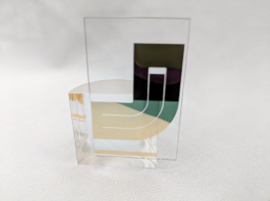Summary
We explore the physics of the transfer of photon momentum to free electrons in thin metal films, including unexpected phenomena such as the counterintuitve sign of the resulting electron current ("photon drag current") and its strong perturbation by surface adsorbates. We leverage photon drag to build integrated molecular sensors and ultrafast optical detectors, as well as to probe the fundamental form of the optical force density in matter, an unresolved question to this date.
Description

The photon-drag (PD) effect is the rectified electrical current in a medium generated by radiation pressure. That is, the optical force delivered to an illuminated metal results in a measurable voltage across the film (Figure, left). For decades, this effect in metals has been understood in terms of momentum conservation. Intuitively, a metal’s free electrons are “pushed” by light, and the resulting current arises simply according to momentum balance. But our own recent measurements of this effect in gold, a nominally simple metal, have thrown this intuition into disarray [1]. We discovered that the sign of the PD signal for pristine gold films, for both s- and p-polarized light, is opposite to that one would expect for direct momentum transfer to free electrons. This result challenges the intuitive notion that radiation pressure acts on free electrons in a simple manner, raising new questions on the nature of momentum transfer in light-metal interactions. In the same measurements [1] (Figure, middle), we further discovered that the photovoltages generated by p-polarized light illuminating gold are strongly dependent, in both sign and magnitude, on surface adsorbates. The environmentally sensitive PD effect is thus a novel sensing platform, but the underlying physics remains unexplained and unexplored.
We are currently investigating the open questions of the (i) counterintuitive sign and (ii) environmental sensitivity, while leveraging these anomalous PD effects to implement plasmonic-waveguide-based integrated devices [2] (Figure, left) for molecular sensing (as a compact replacement for standard surface plasmon resonance (SPR) equipment) or ultrafast balanced photodetection (leveraging the record short momentum relaxation times of electrons in metals). Finally, the environmental dependence of the p-wave PD signal also suggests an answer to a longstanding question in electrodynamics: the form of the optical force density in a non-magnetic ponderable medium [3]. The “Ampere-Chu” form −(∇∙𝑃)𝐸+𝐽×𝐵 yields, for p-waves, a surface-confined optical force, precisely where the recipient charge concentration is susceptible to modulation by surface adsorbates, and thus appears as more plausible than the alternative “Einstein-Laub” form 𝑃 ∙(∇∙E)+𝐽×𝐵 which, though also consistent with global conservation of momentum, predicts a force density located in the bulk of the metal.
- Strait, J., et al. Revisiting the photon drag effect in metal films, Phys. Rev. Lett. 123 053903 (2019)
- Strait, J., et al. 2. Integrated Photodetection Leveraging Radiation Pressure, Frontiers in Optics (OSA, 2020)
- Strait, J., et al. 2. Determining the nature of opticalforces with the photon-drag effect, Frontiers in Optics (OSA, 2019)
Highlights

Highlight: Light seems to pull electrons backward
Light hitting a metal surface at an angle sends the electrons moving in the direction opposite to the light, a result that puzzles theorists. “Physicists have long assumed that light hitting a metal surface at an angle pushes on the free electrons, moving them forward, yet some recent experiments show the opposite—incident light seems to pull electrons backward. Based on new experiments [1], a team of researchers now offers partial clarification, at least on the experimental side. Metals in vacuum act one way, while those exposed to air behave differently, possibly because the light first interacts with molecules attached to the surface. The experiments cast doubt on researchers’ basic understanding of how light interacts with solid materials, knowledge that lies at the core of modern photonics technology… Hoping to explain the differences, researchers led by Strait and Henri Lezec, also at NIST, have now conducted a new set of experiments. In an initial experiment, Strait and colleagues tried to simplify the problem, experimenting with light striking a thin gold film held in vacuum, where no stray molecules could affect the metal surface. The team aimed an infrared laser toward the metal surface at a glancing angle and placed an electrode at the far end of the metal sample. This electrode would detect any voltage created if the light drove the electrons along the metal, which would create an excess of negative charge at the far end. As they varied the angle, the team measured a voltage that largely agreed with theoretical expectations based on the simple light-pushing-electrons picture. However, the voltage they measured was the opposite of that expected, implying that the current flow was in the wrong direction. It’s a weird effect," says Strait. “It’s as if the electrons are somehow managing to flow backward when hit by the light.” The team also conducted experiments with the metal exposed to air, and in striking contrast, the light pushed the electrons forward. These results show that the previous experiments weren’t actually inconsistent, but that light’s interactions with a metal surface are far more complex than was previously believed, says Strait. “We can no longer ignore this counterintuitive backwards current,” he says. “It is a surprising indication of the complexity of the solid-state system.” “This finding is most unexpected and puzzling,” says quantum optics specialist Stephen Barnett of the University of Glasgow in the UK. “I'm really not quite sure what to make of it. Clearly there remains much to be understood in the interaction between light and surfaces”. “One very speculative idea, says Lezec, is that the incident photons may act not only on the free electrons in the metal, but also on so-called core electrons, which are not free to move through the material”. In some unknown way, he suggests, these might act to produce a current in the opposite direction.
- Buchanan, M., Light seems to pull electrons backward, Physics 12 88 (2021)

